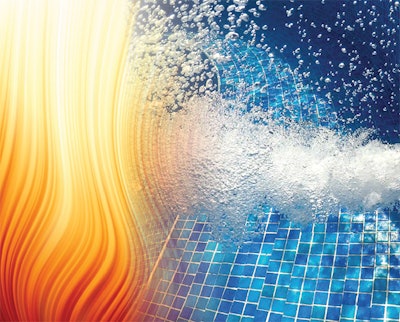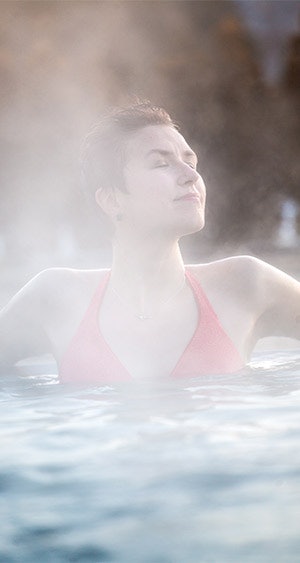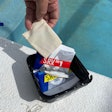

Is there more than one way to heat a hot tub? Of course there is. From electric and natural gas to solar, heat pumps and external heat exchangers, there are numerous ways to raise water temperature. While that is true in the broad sense, in the narrower world of portable hot tubs, virtually all portable units use electric heaters and there appears very little to no reason to consider other technologies.
That is, however, only part of the story. The instant you move away from the portable concept and into larger systems — inground concrete spas (attached or standalone) and large commercial hot water vessels found at health clubs and resorts — the possibilities open up with electrical heat usually giving way to fossil-fuel heat sources.
COMPACT APPLICATION
Starting with portables, there is no question about the ubiquitous and overwhelming dominance of electric heaters. According to Brian Koops, vice president of engineering and technical services for Jacuzzi, 100% of the company's models use electric heaters.
"The reason for that," he says, "really has to do with the device itself. The pro side of electric heaters is they are extremely reliable and compact so they are easily contained within the spa cabinet. It's just the one utility that is already required to operate everything else on the spa, so there's no need for an additional source of energy."
Jim Milligan, CEO of Nespa, a manufacturer of prefabricated custom spas — many of which do not use electric heaters (more on that below) — says the convenience factors of electric heat reign supreme in the portable world.
RELATED: A History of Innovation: Hot Tubs
"It speeds the manufacturing process and it absolutely speeds the installation process. It's only going to cost you $500 to bring in your 60 amps, or whatever the magic number is, hook it up and you're done. That's why electric heaters dominate the portable market. It's clean, simple and easy to service. When something does go wrong, it takes a dealer 20 minutes to swap a pack out. It's like a circuit board, you pull it out, plug a new one in, and you're good to go. When you introduce other heat sources, you lose
those benefits."
Electric heaters play their role so well that the spa manufacturers contacted for this discussion report that there has been very little in the way of product evolution in electric heaters, at least the ones used in their somewhat in recent years, but mostly in the materials they use to manufacture them," says Eric Hales, director of product development for Bullfrog Spas. "That's been mainly to fight corrosion. Because of the better materials, it does translate into better transfer of energy. Mostly, electric heaters have been a great fit for this application."
EFFICIENT USE
Even the staunchest proponents of electric heat acknowledge that for all of the advantages described above, it does not heat water as quickly as gas heaters, with average hourly temperature rise ranging from four to six degrees, depending on the volume of water and size of the heater. That's not a problem, so long as the homeowner's expectations are properly calibrated.
"The challenge from a customer perspective is balancing performance with perceived need," Hales says. "If you want to take 60-degree water and raise the temperature to over 100 degrees, and have it ready for that evening, that's a different heater and a different way of using the system than if you maintain a higher base operating temperature with a more efficient heater. The customer has to understand how they want to use their spa. You can put a 5½-kilowatt heater on a spa and it will heat up really fast. But that speed will cost you money over the long term of the spa's use. That's opposed to having a 4-kilowatt heater that will maintain your spa at a certain temperature and always be there without using that extra energy."
Energy consumption and system efficiency standards in portables are largely dictated by the California Energy Commission, which requires spas sold in the Golden State satisfy requirement for annual energy usage based on volume. "It's a voluntary standard, but you have to comply with it if you want to sell within California, and more and more states are adopting that standard," Koops explains.
"From the electric heater standpoint," he adds, "the systems are designed so the water is in direct contact with the heating elements, so 100% of the energy coming off those elements is transferred into the water. That's not to say the overall system is 100% efficient, because there's heat that's lost outside of the water. Because the electrodes are immersed in the water, the energy has nowhere else to go. What you do with that hot water and how you manage it is more of a system level."
RELATED: Heat Pumps and Gas: North vs. South
Managing system efficiency, especially when it comes to preventing heat loss, is a consuming challenge for manufacturers. As Hales explains, "We use full foam insulation and fill
it completely, with the exception of the equipment area where we want to dissipate some of the heat away from the equipment. We also have minimum plumbing, concentrating the size of plumbing and amount of hose that we use in order to allow that area to be filled with foam, rather than with pipes containing moving water that could be cooling. That increases the overall efficiency of the spa because we're losing less heat to the outside.
"We're also increasing hydraulic efficiency by focusing on the flow that's delivered to the consumer in the form of therapy. Those are just a couple of ways we're working to increase efficiency."
"Insulation is part of the whole story," Koops says. "We look at the entire spa system in terms of function and energy efficiency. We look at any opportunities we have to improve in those areas. So whether that's a high-efficiency insulated cover, or insulation in the cabinet itself, or on-board software that manages our heat calls, and our pump size, it all plays a role."
BEYOND ELECTRIC
As mentioned above, Milligan uses both gas and electric in his premanufactured custom spas, which in many cases are larger than more typical portable units and often purchased by clients with a range of expectations.
"You sort of have to have a playbook for the different scenarios," he says. "You have to explain it to them with very clear and realistic expectations. It's really about the cost of getting where you want to be," he says. "There's no question you get a more rapid heat rise with natural gas, so it depends on what the temperature you want to achieve is, and what your starting point is and how fast you want to get there. Then there's the issue of maintaining that temperature.
"The approach with natural gas is going to be different than with electricity when you're heating a spa." Milligan continues. "The energy source selected is going to determine how quickly the spa is going to be ready for use. It's going to be much faster with gas. But if you're maintaining a base temperature of 80 degrees and don't mind waiting for the spa to heat up more slowly, then electricity works just fine. What that costs is going to be based on the cost of the chosen energy source."
RELATED: Bring On The Heat
In some situations, the decision to go with gas instead of electricity comes down to fundamental issues such as whether an insulated cover will fit on the vessel itself. "Residentially, when we go electric it is mandatory that we have a cover, not an auto-cover, but an insulated cover. The problem is that you're limited to the size, about 100 inches wide, taking into account about a minimum of 5 inches on each side for the cover to sit on, now you're down to 90 inches, or 7½ feet. If you go bigger than that, you don't really have a cover option. It's the same with a freeform vessel; the spa really needs to be rectilinear so you get into a design constraint."
On commercial spas, which are large, used every day and remain uncovered throughout the day, fossil fuel heating emerges as the clear choice.
"When you move into commercial projects, where it's open from 8 a.m. to 10 p.m., it's not going to be covered all that time, and it's always got to be ready to go, so a gas system or heat is the better choice," Milligan says. "In our work, we're looking at all the factors, cost of energy, ambient temperatures, client expectations and anticipated use. There's really no such thing as one-size-fits-all."
EXTERNAL HEAT EXCHANGERSIf there is an alternative heating method for portable spas beyond the electric heater, it may be found in the concept of the external heat exchanger. These components tap into existing heating systems that enable the spa to be heated in conjunction with the home. In Europe, where the use of geothermal energy is more fully developed, heat exchangers enable extremely low-cost alternatives to traditional electric heat and are seen as a way to increase the environmental sustainability of spa system operation. Using a heat exchange system does not require the installation of dedicated spa heating equipment, gas lines and ventilation, and can provide the rapid heat rise associated with fossil fuel heating. Switzerland is mandating the use of heat exchanges for new spas and reportedly other countries on the continent are weighing similar measures. Whether or not use of external heat exchangers will catch on in the U.S. remains to be seen. |








































